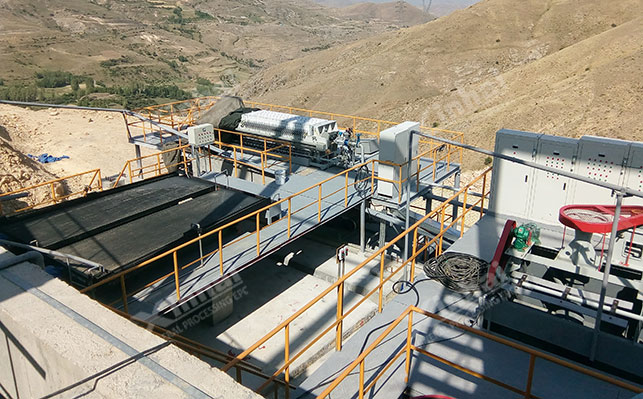
15311826613
Click to add WeChatPhosphate ore is an important non-metallic mineral resource, which is widely used in agriculture (production of phosphate fertilizer), chemical industry and other fields. Flotation is one of the main methods of phosphate ore beneficiation, which can effectively separate phosphate minerals from gangue minerals and improve the grade and quality of phosphate ore. This article will introduce the main processes of flotation phosphorus selection in detail.

Positive flotation is to use collectors to float phosphate minerals, while gangue minerals remain in the slurry. Fatty acid collectors are usually used, which have good selectivity for phosphate ore. During the flotation process, fatty acid radical ions chemically adsorb with calcium ions on the surface of phosphate ore, making the surface of phosphate ore hydrophobic, so that it can attach to bubbles and be brought to the surface of pulp to form a foam layer. The principle process is: after the raw ore is crushed and ground, the pulp enters the flotation tank. First, add an adjuster to adjust the pH of the pulp, generally adjust the pH value to about 8-10, and then add fatty acid collectors such as oleic acid, sodium oleate, etc., and introduce air to produce bubbles. Phosphate ore particles attach to the bubbles to form foam products, while gangue minerals remain at the bottom of the tank and are discharged as tailings.
The process is simple to operate, and for some easy-to-select phosphate ores, a higher phosphorus recovery rate and grade can be obtained. However, for complex ores, due to the difficulty of separating gangue minerals from phosphate ore, other processes or adjustments to the reagent system may be required.

Reverse flotation is to float the gangue minerals and leave the phosphate minerals in the pulp. Commonly used collectors include starch, dextrin, etc. These collectors can selectively adsorb on the surface of gangue minerals, making the gangue minerals hydrophobic and floated out. The principle process is: after the original ore is crushed and ground, an inhibitor is first added to inhibit the phosphate ore, such as water glass. Then a reverse flotation collector, such as starch, is added to make the surface of the gangue mineral hydrophobic. During the flotation process, the gangue minerals are brought to the surface of the pulp by bubbles to form a foam product, while the phosphate ore remains at the bottom of the tank as a concentrate.
The reverse flotation process has a good effect on some high-magnesium and high-silicon phosphate ores. It can effectively remove gangue minerals and improve the grade of phosphate ore. However, the selection and dosage of reverse flotation collectors need to be precisely adjusted according to the properties of the ore, otherwise it may affect the flotation effect.

The double reverse flotation process is mainly aimed at phosphate ores containing multiple gangue minerals, especially those containing both magnesium gangue (such as dolomite) and siliceous gangue. This process removes magnesium gangue and siliceous gangue respectively through two reverse flotations. The primary reverse flotation is mainly to remove magnesia gangue. A collector specifically for magnesia gangue is used to make the surface of magnesia gangue minerals hydrophobic and float out. The secondary reverse flotation is to remove siliceous gangue. A collector suitable for siliceous gangue is used to float and remove it. The principle process is: after the primary flotation, an adjusting agent is added to adjust the pulp environment, and then a collector for magnesia gangue, such as fatty acid derivatives, is added to float the magnesia gangue minerals. The slurry after flotation enters the next flotation tank for secondary reverse flotation, and a siliceous gangue collector, such as amine compounds, is added to float and remove the siliceous gangue minerals, and finally a high-grade phosphate concentrate is obtained.
The double reverse flotation process can effectively process complex phosphate ores and improve the grade and recovery rate of phosphate ores. However, this process requires the use of multiple reagents, and the process flow is relatively complex, and the operation and management requirements are high.

The combined ore dressing process of phosphate ore is mainly a separation operation completed by a combination of two or more processes, with the purpose of improving the recovery rate and grade of phosphorus. Several common combined flotation methods are as follows:
Flotation-gravity separation: Among them, flotation is used to remove most of the gangue minerals and improve the grade of phosphate ore; gravity separation can further purify the product after flotation and remove some impurities that are difficult to separate during the flotation process. This combined phosphorus separation process can improve the beneficiation effect of phosphate ore and is suitable for some occasions with high requirements for the grade of phosphate ore. However, since it involves two different beneficiation methods, the equipment investment and operating costs are relatively high.
Flotation-magnetic separation: When the phosphate ore contains magnetic impurity minerals, this combined process can be used, in which flotation removes non-magnetic gangue minerals and magnetic separation is used to remove magnetic impurity minerals. This combined process can effectively treat phosphate ore containing magnetic impurities, but it is necessary to select appropriate magnetic separation equipment and parameters according to the magnetic characteristics of the ore.
The above is an introduction to several methods of flotation phosphorus selection. In actual beneficiation plants, due to the different properties of phosphorus ores, the choice of flotation methods is also different. It is recommended to conduct ore dressing test analysis first, and select a suitable flotation method according to the actual situation to improve the efficiency, grade and recovery rate of phosphorus beneficiation.